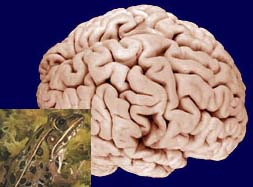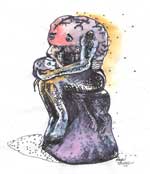Serendip is an independent site partnering with faculty at multiple colleges and universities around the world. Happy exploring!
"Reality" and the I-function

|
Biology 202
|
 |
Class discussion - 22 April
What do we mean by "reality"? What is the I-function doing?
Reality does exist. The fact that everyone in the classroom can agree that we are all in a biology class gives proof that biology class is real. It was brought up that some people have altered realities. Since some people have altered realities, does this mean that there is no reality at all? The group's answer to this question was no. There is a reason that people are diagnosed with mental disorders - the reason is that they're "reality" is different than the accepted reality. This then led into the discussion that perhaps the accepted reality of the greater population is not real. Perhaps we're all just microbes living in an environment on some giant's hand. The majority of the group dismissed this as being unlikely. Nevertheless, the possibility remains...
Regarding the I-function's role in reality, we decided that the I-funtion serves as a screen between reality and what we perceive as reality. Hallucinating people has a skewed sense of reality because their I-function distorts the actual reality from what they perceive as reality. When someone is upset or angry, s/he is less likely to take a joke well. However, when someone's I-function is in a better mood, s/he is more likely to take a joke well.
Group members: Paul Bloch, Jackie Marano, Anna Giuratana, Rica Dela Cruz, Michelle Crepeau, Caitlin Jeschke, Evan Stiegel, Penn Tong
Reality is a cultural construction of agreed norms. May differ from individual reality. For the same input, there are different ways it may be processed. This is where the I-function comes in and "personalizes" the experience. Thus the common input is reality but everyone's individual experience is also an individual reality. Reality is layered as is people's experiences of it. There are many realities !!!!!!! The I-function picks up on a very small portion of reality. Acts as a filter and recruits(?) to form a reality. Awareness is not only in the I-function. Perception versus awareness.
Group members: Nana Asabere, Molly Pieri, Angel Desai, Jessica Varney, Margaux Kearney, Meredith Tuohey, Anne Kauth, Jean Chung, Lisa Lamprou, Sophie Feller, Michelle Khilji
Our group concluded that the I-function is one of the contributing factors in the unique reality that each of us constructs. It is also something that can integrate all of the incoming information and sometimes consciously override initial perceptions, as in the case of the sign mis-spelling that none of us could see at first. As to the nature of reality, we do not believe that there is a universal reality that we may definitively determine. We do, however, believe that there are some underlying principles which govern the realities that each of us sees that allows us to interact effectively and adaptively with one another. We also discussed how interactions with other people and species might allow comparisons of our different realities and help us come closer to not necessarily what is the most accurate conception of reality, but the most useful one in terms of how we can relate to each other.
Our group also felt that it is not necessary to say that one version of reality is more valid than another, only that more people might agree on a version of reality than another. Another factor we discussed that contributes to people's different versions of reality was implicit social processes, like those described in the book Blink, by Malcolm Gladwell. First impressions and stereotypes unconsciously guide our interpretations of people, and thus impressions of people may or may not be similar to other people's perceptions of those same people or the so-called definitive reality of that person.
Group members: Maggie Simon, Kendra Smythe, Caroline Feldman, Marie Sager, Jen Benson, Jenn Wong, Julianne Rieders, Paige Safyer
There is no truth in that we can't define the ultimate or certain reality. No one person can detect all of reality, and we all construct individual realities based on our perceptions. The brain inhibits the perception of extraneous information and focuses on certain parts of reality. Long-term memory and experience affect the I-function and how it makes sense of our perceptions. The I-function gathers our different perceptions and tries to make cohesive sense of them. We would like to point out that we are not scared that our reality is a construction of the I-function. And the fact that we all have different individual realities doesn't mean there isn't a universal reality- there has to be something out there. Finally, we discussed evolution: Did early humans perceive more and we've evolved to weed out unimportant information? Or did they perceive less and we have gained more perceptual abilities?
Group members: Mahvish Qureshi, Tara Raju, Elizabeth VerHoeve, Isabelle Winer, Madina Ghazeinfar, Simone Shane, Skye Rhodes-Robinson, Allison Zincke-Robles, Emily Alspector



Comments
Post new comment